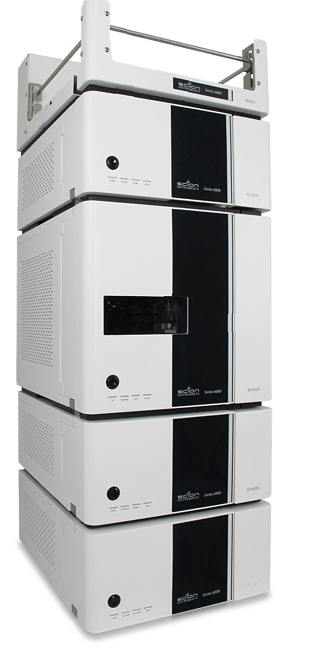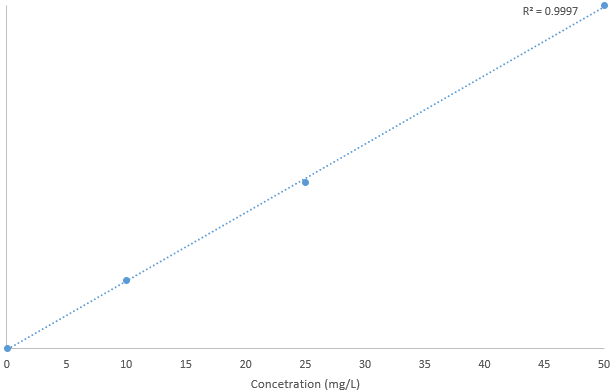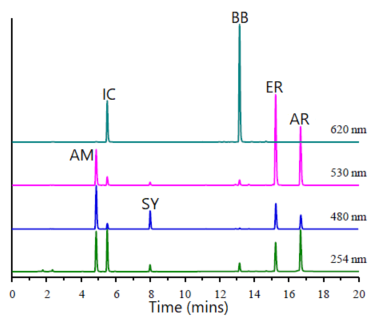Simultaneous Analysis of Synthetic Food Dyes by HPLC-DAD
Introduction
Food colourant additives are common dyes used to enhance the colour and palatability of food and drink products. Dyes used during food manufacturing are divided into natural and synthetic dyes. Synthetic dyes are often added to compensate for the loss of natural colour that occurs during processing and storage of food products. Additionally, synthetic dyes offer better stability, brightness and lower cost compared to natural dyes. Due to concerns about the potential health risks from the consumption of artificial food dyes, synthetic colourants are subject to regulation.
Global regulations can vary as to which dyes are allowed, specific foods they can be used in and regulatory limits. For example, the Food and Drug Administration (US) allows the use of Sunset Yellow, Brilliant Blue, Indigo Carmine and Erythrosine.
SCION Instruments developed a HPLC-DAD method for the simultaneous identification of six synthetic dyes at varying wavelengths. Utilising the DAD, it was possible to extract the optimal wavelength for each target compound.
Experimental
A SCION 6000 HPLC-DAD was used with a C18 reverse phase column for the simultaneous detection of six synthetic food dyes, shown in Figure 1.

Figure 1. SCION 6000 HPLC
The identification of each target compound and abbreviations used throughout this application note and the extracted wavelength of each compound can be found in Table 1.
Table 1. Target compounds, abbreviations and extracted wavelengths (nm)
| Compound | Abbreviation | Wavelength (nm) |
| Sunset Yellow | SY | 480 |
| Amaranth | AM | 530 |
| Erythrosine | ER | 530 |
| Acid Red 52 | AC | 530 |
| Indigo Carmine | IC | 620 |
| Brilliant Blue | BB | 620 |
The DAD was additionally set to 254nm, the primary wavelength. Calibration standards were prepared at a range of 0.5mg/L to 50mg/L for each target compound. Table 2 details the analytical conditions for this analysis.
Table 2. Analytical conditions of HPLC-DAD
| Conditions | |
| Column | C18 3µm x 4.6mm ID x 150mm |
| Column Temp | 40°C |
| Mobile Phase | A 10mmol/L ammonium acetate/ acetonitrile (95:5)
B 10mmol/L ammonium acetate/ acetonitrile (50:50) |
| Gradient | 0 min B:2% A:98%
21min: B100% |
| Flow Rate | 1mL/min |
| Injection Vol | 10µL |
| DAD | 254nm, 480nm, 530nm, 620nm |
Results
Calibration standards were analysed over a concentration range of 0.5mg/L to 50mg/L. Figures 2 and 3 show the calibration curve of two target compounds, Brilliant Blue (BB) and Acid Red 52 (AR), which are representative of all target compounds analysed.

Figure 2. Calibration curve of BB; 0.5mg/L to 50mg/L

Figure 3. Calibration curve of AR; 0.5mg/L to 50mg/L
All target compounds exhibited high linearity with an R2 value >0.999, over the wide linear range.
Along with the set wavelength of 254nm, varying wavelengths were extracted as the optimal wavelength for each food dye analysed. Figure 4 highlights the overlay chromatogram of all wavelengths used throughout this application.

Figure 4. Overlay chromatogram of target analytes (extracted wavelengths)
When analysed at 254nm, all target compounds can be identified. However, all target compounds have different maximum UV absorption wavelengths which were extracted for peak identification. Utilising the extracted wavelength feature of the DAD allows for a simultaneous analysis rather than individual methods for different compounds.
Conclusion
SCION Instruments offers the ideal solution for the identification of six simultaneous food dyes by HPLC-DAD. By utilising the extracted wavelength mechanism of the DAD, it is possible to use the optimal absorption wavelengths for each individual compound, eliminating the need for individual methods.
Download Application Note
Download the complete Application Note: Simultaneous Analysis of Synthetic Food Dyes by HPLC-DAD
SCION 6000 HPLC-DAD
A SCION 6000 HPLC-DAD was used to conduct this research. Providing excellent solutions for the simultaneous detection of six synthetic food dyes. Find out more about the SCION LC 6000.
If you would like to get in touch with a member of our team, please don’t hesitate to contact us. Or to stay up to date with future research and articles from SCION Instruments, sign up to our news letter via the button below or follow us on LinkedIn, Facebook and Twitter.
